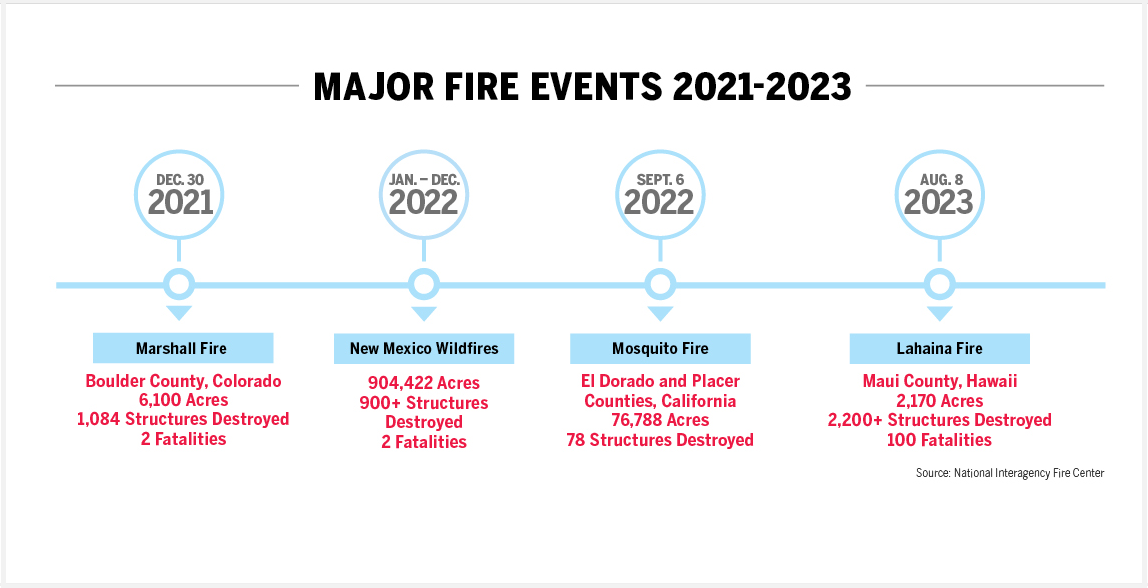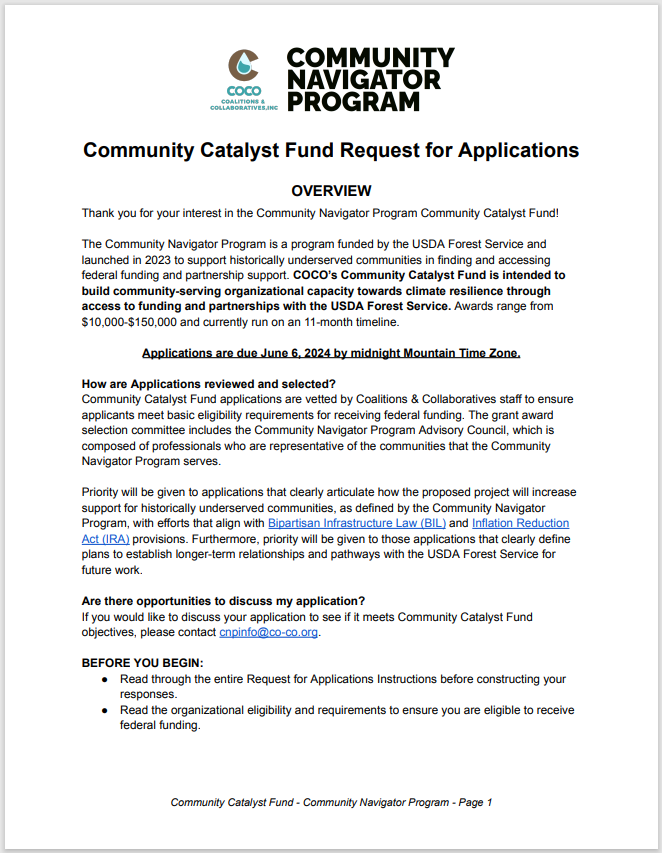Happy May, Fireshed friends!
National Wildfire Preparedness Day, held annually on the first Saturday in May, is celebrating its ten-year anniversary this Saturday, May 4, 2024! We invite you to join thousands of individuals and communities across the United States in devoting anywhere from a few hours to the entire day performing a variety of tasks to reduce the risk of damage or destruction by wildfire to homes and property. Since 2014, this nationwide day of effort has been coordinated by the National Fire Protection Association (NFPA) in collaboration with Fire Adapted Communities and State Farm Insurance. While NFPA produced educational printed materials and other resources focused on wildfire prevention for many years, partnering with insurance companies and learning networks enabled them to expand their outreach efforts. The effort has grown over the past decade, giving participants a chance to network, connect with others in their communities partaking in the effort, and work with organizations they may not typically think of when smoke is in the air.
Today’s Wildfire Wednesday features:
Stay cool and connected,
Rachel
An Overview: Wildfire Preparedness Day
Each year, Wildfire Community Preparedness Day actively encourages groups and individuals living in wildfire-prone areas to complete projects that can help make their homes and communities safer from wildfire. As co-sponsors of Wildfire Community Preparedness Day, NFPA and State Farm are working to celebrate the campaign’s positive impact on countless homes and communities over the past decade.
With a vested interest in property loss reduction and personal safety, State Farm has played an active role in supporting the campaign since its inception. This year, to encourage participation during the campaign’s 10-year anniversary, NFPA and State Farm are offering a free banner to the first 100 people who develop a campaign project or event and post it online. This can be done by filling out the online form that tracks and maps community participation in the campaign nationwide.
As wildfires continue to present an ever-growing threat to households nationwide, more communities are recognizing the power of teaming up to proactively address them. I’m incredibly proud of the progress we’ve seen over time and fully expect that the level of participation and enthusiasm in Wildfire Community Preparedness Day will continue to grow this momentous year and beyond.
— Lorraine Carli, NFPA vice president of Outreach and Advocacy
Wildfire Community Preparedness Day provides science-based steps people can take to reduce or remove potential fire hazards from a home and its immediate surroundings – known as the “home ignition zone” – to help protect from embers and radiant heat from wildfires. Typical activities might include simple, low-cost home improvement projects such as clearing dead leaves, debris, and pine needles from roofs and gutters; keeping lawns and native grasses mowed to a height of four inches; or removing anything stored underneath decks or porches that could burn.
For more information about Wildfire Community Preparedness Day, project ideas, and free resources to download and share, including a campaign toolkit, visit wildfireprepday.org.
Resources for May 4
Where to start: an instructional video
On April 4, NFPA hosted a Facebook Live event in support of Wildfire Community Preparedness Day on May 4. Watch the video here to get helpful tips and the resources you need to start planning for a Prep Day event in your area.
Easy guidelines: Wildfire Preparedness Factsheet
This easy-to-share factsheet can help others in your community learn more about Wildfire Preparedness Day and what they can do to make a difference. “Studies show that measures taken at the home and in the area within 100 feet of it, known as the Home Ignition Zone (HIZ), have a significant impact on minimizing damage and loss. Something as simple as clearing the immediate 5-foot zone around the home can assist in making a huge difference in avoiding a catastrophe.”
Wildfire Community Preparedness Day Toolkit
This year, Preparedness Day is focused on what residents can do on and around their home to help protect against the threat of wildfires. The Prep Day toolkit provides a list of project ideas, safety tips, and more, to help guide you towards event day.
Local Wildfire Preparedness Events
Many community leaders and members, including Fire Adapted New Mexico (FACNM) Leaders, have hosted or are gearing up to facilitate Wildfire Preparedness Events in their communities on or around Wildfire Prep Day! Ahead of the annual event, FACNM received funding from WPD parent organization, NFPA, and has distributed nearly $20,000 to support 12 local events for members and leaders. This is made possible through the semi-annual FACNM microgrants award program. Read on to learn about some of the events happening around the state and to find motivation to host the next wildfire preparedness day in your community!
Ready, Set, Go: A Wildfire Preparedness Workshop presented by Fire Adapted New Mexico Learning Network, Greater Santa Fe Fireshed Coalition, and Villages of Santa Fe.
It was a typical Santa Fe spring day this past Saturday, April 27, at Christ Church, starting with snow and ending with sunshine. More than 50 attendees gathered for a variety of presentations and activities related to community wildfire preparedness. The SimTable captivated audiences with its ability to visually project fire traveling in and around Santa Fe, translating the idea from abstract concept to concrete representation. A presentation on Go Kits sparked great conversations about what it really means to be prepared and have a plan when fire arrives. Home Hazard Assessments, presented by Alyssa Mineau from the Forest Stewards Guild, provided participants with a actionable starting point for working on their homes and communities. By the end of the day, several HOA and community leaders had expressed interest in presenting the Ready, Set, Go! program to their neighborhoods – a great example of how community preparedness events motivate and expand community outreach. Mayor Alan Webber gave opening remarks and a reporter from the Santa Fe New Mexican covered the event.
A new presentation, How Does the Threat of Wildfire Affect Your Home Owner's Insurance, sparked some great questions from the audience. The panel, moderated by Madeline Carey, gave an overview of what residents of the Santa Fe area can expect, including how to respond to insurance companies and the threat of losing coverage. Panelists included Lou Macias and Melissa Robertson from the Office of Superintendent of Insurance, Chris Schaum from Chris's Tree Service, and George Ducker, Wildfire Prevention & Communications Coordinator from The New Mexico Energy, Minerals and Natural Resources Department (EMNRD) Forestry Division. The Realtor Association expressed interest in presenting the program to local realtors.
Other Community Wildfire Preparedness Day events organized by FACNM Leaders and Members around the state
La Barbaria Canyon and Tesuque will both be holding chipper events and community green slash disposal days on May 4.
Santa Fe Audubon Society will be preparing an educational defensible space forest thinning demonstration area within the next year. Keep an ear out for opening announcements!
Taos Pines will hold their annual fire preparedness meeting over the July 4 weekend, reminding existing residents and educating new residents on personal and community fire preparedness practices and resources.
Turley Mill HOA is hosting a workshop to teach residents about defensible space.
Brazos Firewise Community will hold a community chipper event and community green slash disposal day over the summer.
And more…
FACNM and the Greater Santa Fe Fireshed Coalition are proud to support members and leaders leading the charge for fire readiness in their communities. Keep an eye on this page to read all about events and efforts funded through the microgrant award program over the summer. To learn more and become eligible to receive a microgrant award, consider joining the learning network as a member or leader.
Upcoming Events, News, and Resources
May Wildlife Webinars
Tuesday, May 7, 2024, 12:00 – 1:00 p.m. MT: Bird Communities of the San Juan Mountains of Colorado: A Citizen Science Project
Over the past 5 years, community volunteers from the Weminuche Audubon Society have conducted a study of bird communities in Ponderosa Pine-dominated forested sites that received wildland fuels reduction treatments. This webinar from the Forest Stewards Guild dives into the effects of these treatments, specifically prescribed fire or shrub-layer thinning, on the composition of bird communities in the southern Rocky Mountains, showing that tree canopy and shrub-layer composition and structure have important influences on the number of bird species present and the predominate feeding and nesting behaviors of the avian community.
Tuesday, May 14, 2024, 12:00 – 1:00 p.m. MT: Bird Population Trends and Climate Effects in Southwestern National Parks
Climate change is considered a major driver of recent avian population declines, particularly in the drought-stricken southwestern United States. Predicting how bird populations will respond requires understanding the climatic drivers influencing population density across the region’s diverse habitats. In this webinar from the Forest Stewards Guild, Harrison Jones of The Institute for Bird Populations discusses his research modeling breeding-season densities of 50 bird species in relation to spring and summer drought and the timing of North American monsoon rainfall.
Tuesday, May 21, 2024, 12:30-2:00p.m. MT: Wildlife and Fire: From Borders to Biota, Monitoring at Multiple Scales
In the second webinar of a yearlong Wildlife and Fire series from the Southwest Fire Science Consortium and partners, a panel of experts will discuss monitoring and collaboration at multiple scales at the intersection of fire and wildlife. Topics include the study of how fire and thinning may impact several important soil organisms that support forested wildlife habitat, large-scale monitoring of border infrastructure impacts on wildlife, stories from habitat recovery within large wildfire footprints, collaborations to manage sage grouse and their habitat, and observations on intra-agency differences coordinating wildlife management and fire recovery. Register to learn more about monitoring at multiple scales on May 21!
Home Hazard Assessments
Wednesday, May 22, 2024, 1:00-2:00pm: Back to Basics: All About Home Hazard Assessments
In this webinar from Fire Adapted NM, knowledgeable fire and forestry professionals from New Mexico and Colorado will introduce an important fire risk and readiness tool: Home Hazard Assessments (HHAs). Topics covered will include guidance and digital and printed tools to complete HHAs, local partners who can guide the process or travel to complete HHAs on-site alongside property owners and residents, how different Assessment programs are structured, why HHAs are an important fire readiness tool, how county ordinances and insurance providers can influence the need for HHAs, and what opportunities may open up as a result of completing them. Join us on May 22 to learn about Home Hazard Assessment and find out how you can access this tool!
What: Webinar on Home Hazard Assessments (HHAs), hosted by FACNM
When: May 22 from 1:00-2:00pm
Where: Zoom; registration is required and a recording will be available
Who: Open to the community with presenters Porfirio Chavarria of City of Santa Fe Fire, Dick Cooke of Village of Ruidoso, and Kyle McCatty of Wildfire Partners.
An in-person Home Hazard Assessment workshop will be held in autumn 2024 in conjunction with the New Mexico Wildland-Urban Fire Summit (WUFS). Registration for the workshop will be announced beginning in August.
Funding Opportunities
Community Catalyst Fund Request for Applications
The Community Navigator Program is a program funded by the USDA Forest Service and launched in 2023 to support historically underserved communities in finding and accessing federal funding and partnership support. The Community Catalyst Fund, offered by Coalitions and Collaboratives, is intended to build community-serving organizational capacity towards climate resilience through access to funding and partnerships with the USDA Forest Service. This funding opportunity is designed to accommodate projects of various sizes and scopes, including: capacity building through training, development and staffing; navigation program delivery; knowledge sharing through stories and resource exchange. Learn more!
Awards range from $10,000-$150,000 and currently run on an 11-month timeline.
Applications are due June 6, 2024 by midnight Mountain Time Zone. COCO will hold a Community Catalyst Fund virtual Q&A session on April 30, 2024 at 2pm MT. Register here. Email cnpinfo@co-co.org with any questions.











